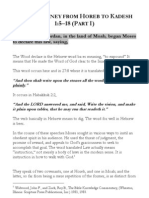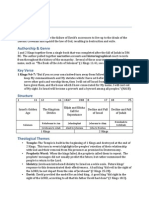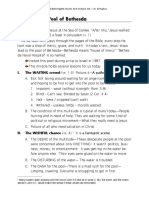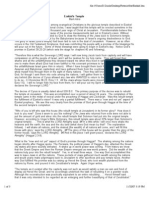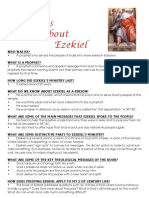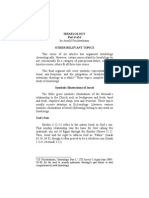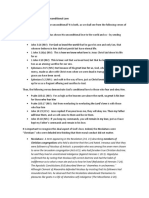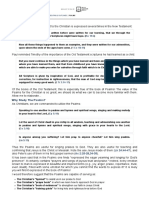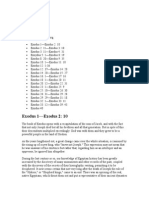The Five Levitical Offerings
The Five Levitical Offerings
Uploaded by
durrashCopyright:
Available Formats
The Five Levitical Offerings
The Five Levitical Offerings
Uploaded by
durrashOriginal Description:
Copyright
Available Formats
Share this document
Did you find this document useful?
Is this content inappropriate?
Copyright:
Available Formats
The Five Levitical Offerings
The Five Levitical Offerings
Uploaded by
durrashCopyright:
Available Formats
THE FIVE LEVITICAL OFFERINGS
The Sacrifices
The sacrificial system was ordained
by God and placed at the very center
and heart of Jewish national life.
Whatever the Jews may have thought
of it at the time, the unceasing
sacrifice of animals, and the never-
ending glow of fire at the altar of
sacrifice, there is no doubt that god
was burning into the hearts of every man, an
awareness of their own sin. An object lesson that
would make your skin crawl was to be an age long
picture of the coming sacrifice of Messiah. The
sacrifices pointed to Him and they were fulfilled in Him.
There are many instructions for sacrifice throughout
the Pentateuch, but Leviticus chapters 1-7 is
completely dedicated to the 5 Levitical offerings which
were the main sacrifices used in the rituals. They
describe 5 kinds of sacrifices: The burnt offering,
the meal offering, the peace offering, the sin offering,
and the trespass offering. Each of the sacrifices were
uniquely fulfilled in Jesus Christ.
The Burnt Offerings
The burnt offering was a sacrifice that was completely
burnt. None of it was to be eaten at all, and therefore
the fire consumed the whole sacrifice. It is also
important to note that the fire on the altar was never
to go out:
Lev 6:13 'A fire shall always be burning on the
altar; it shall never go out.
The common Israelite worshipper brought a male
animal (a bull, lamb, goat, pigeon, or turtledove
depending on the wealth of the worshipper) to the
door of the tabernacle.
Lev 1:3 'Let him offer a male without blemish; he
The
Tabernacle | Gloss
ary
Table of Contents
shall offer it of his own free will at the door of the
tabernacle of meeting before the LORD.
The animal had to be without blemish. The worshipper
then placed his hands upon the head of the animal and
in awareness that this innocent animal was standing in
for the sinner he would seek the Lord for forgiveness
and then killed the animal immediately.
Lev 1:4-9 'Then he shall put his hand on the head
of the burnt offering, and it will be accepted on
his behalf to make atonement for him. 'He shall
kill the bull before the LORD; and the priests,
Aaron's sons, shall bring the blood and sprinkle
the blood all around on the altar that is by the
door of the tabernacle of meeting . . . and the
priest shall burn all on the altar as a burnt
sacrifice, an offering made by fire, a sweet aroma
to the LORD.
The priests were also responsible to wash various parts
of the animal before putting it on the altar:
Lev 1:6-9 'And he shall skin the burnt offering
and cut it into its pieces. 'The sons of Aaron the
priest shall put fire on the altar, and lay the wood
in order on the fire. 'Then the priests, Aaron's
sons, shall lay the parts, the head, and the fat in
order on the wood that is on the fire upon the
altar; 'but he shall wash its entrails and its legs
with water.
Later In Israel's history there were burnt offerings
made twice per day, one at morning and one at
evening (when the first star appeared:
Num 28:3-4 "And you shall say to them, 'This is
the offering made by fire which you shall offer to
the LORD: two male lambs in their first year
without blemish, day by day, as a regular burnt
offering. 'The one lamb you shall offer in the
morning, the other lamb you shall offer in the
evening"
The Burnt offering was performed to atone for the
peoples sins against the Lord and was a dedication
offering of ones life before the Lord continually.
The Meal Offerings
The Israelites offered meal (cereals) or vegetables in
addition to the animals. Leviticus chapter 2 mentions 4
kinds of cereal offerings and gives cooking instructions
for each. The sinner could offer dough from wheat flour
baked in an oven, cooked on a griddle, fried in a pan,
or roasted to make bread (as in the offering of the first
fruits). All meal offerings were made with oil and salt
and no honey and leaven were to be used (oil and salt
preserved while honey and leaven would spoil). The
worshipper was also to bring a portion of incense
(frankincense).
The meal offerings were brought to one of the priests,
who took it to the altar and cast a "memorial portion"
on the fire and he did this also with the incense. The
priest ate the remainder unless he was bringing the
meal offering for himself where he would burn the
whole thing.
The purpose of the meal offering was an offering of
gifts and speaks of a life that is dedicated to generosity
and giving.
The Peace Offerings
The peace offering was a meal that was shared with
the Lord, the priests, and sometimes the common
Israelites. The worshipper was to bring a male or
female oxen, sheep, or a goat. The ritual was closely
compared to the burnt offering up to the point of the
actual burning where the animals blood was poured
around the edges of the altar. The fat and entrails were
burned and the remainder was eaten by the priests
and (if it was a free-will offering) by the worshippers
themselves. This sacrifice of praise and thanksgiving
was most of the time a voluntary act.
The Peace offerings included unleavened cakes. The
priests ate all except the memorial portion of the cakes
and certain parts of the animal on the same day the
sacrifice was made, and when the worshipper joined in
and the offering was free-will the worshipper could eat
for 2 days of the whole animal except the breast and
the right thigh which were eaten by the priests.
Jacob and Laban offered a peace offering when they
made their treaty (Gen 31:43 ff). It was required to
make offerings while making a vow of ones life to God
and thanking Him with praise while free-will offerings
were voluntary.
The Sin Offerings
The sin offering expiated (paid the debt in full) the
worshippers unintentional weaknesses and failures
before the Lord.
Lev 4:1-4 Now the LORD spoke to Moses, saying,
"Speak to the children of Israel, saying: 'If a
person sins unintentionally against any of the
commandments of the LORD in anything which
ought not to be done, and does any of them, 'if
the anointed priest sins, bringing guilt on the
people, then let him offer to the LORD for his sin
which he has sinned a young bull without blemish
as a sin offering. 'He shall bring the bull to the
door of the tabernacle of meeting before the
LORD, lay his hand on the bull's head, and kill the
bull before the LORD.
Each class of people had various ordinances to
perform:
Sins of the high priest required the offering of a bull
and the blood was not poured on the altar but
sprinkled from the finger of the high priest 7 times on
the altar. Then the fat was burnt, and the remainder
was burned (never eaten) outside the camp "unto a
clean place" where the sacrifice was made and
the ashes were poured out.
Lev 4:12 'the whole bull he shall carry outside the
camp to a clean place, where the ashes are
poured out, and burn it on wood with fire; where
the ashes are poured out it shall be burned.
Sins of the leaders required the offering of a male
goat. the blood was sprinkled only once and the
remainder was poured around the altar as with the
burnt offering.
Sins of the common Israelites required female
animals, goats, lambs, turtledoves, or pigeons and in
the case of the very poor an offering of grain was
acceptable just like a meal offering.
Unintentional sins were difficult to identify and could
happen at any time and therefore the priests worked
closely as mediators with God and the people and were
there to instruct the people as they sought the Lord. In
case any sins were not brought before the Lord there
were offerings for the nation and for the high priest
which covered them all in a collective way. On the Day
of Atonement (Yom Kippur) the high priest sprinkled
blood on the mercy seat for his own sins and the sins
of the nation.
The Trespass Offerings
The trespass offering was very similar to that of the sin
offering but the main difference was that the trespass
offering was an offering of money for sins of ignorance
connected with fraud. For example if someone
unintentionally cheated another out of money or
property, his sacrifice was to be equal to the amount
taken, plus one-fifth to the priest and to the one
offended. Therefore he repaid twice the amount taken
plus 40 %.
Lev 6:5-7 "He shall restore its full value, add one-
fifth more to it, and give it to whomever it
belongs, on the day of his trespass offering. And
he shall bring his trespass offering to the LORD, a
ram without blemish from the flock, with your
valuation, as a trespass offering, to the priest. So
the priest shall make atonement for him before
the LORD, and he shall be forgiven for any one of
these things that he may have done in which he
trespasses."
Jewish Tradition - The Treatment of Animals
Even though the Lord prescribed the slaughtering of
animals for sacrifice and for food, the treatment of animals
is of the utmost importance in Judaism. The Talmud
describes with minute care and detail how an animal is to
be slaughtered for food, and the regulations are given
mainly because of the desire to inflict as painless a death
as possible. The slaughterer could not be a deaf-mute, or a
minor, and he must be of sound mind (Chul. 1. 1). The knife
must be perfectly smooth without the slightest perceptible
notch and "the knife must be tested as to its three sides
upon the flesh of the finger and upon the nail" (ibid. 17b).
There are five causes of disqualification (ibid. 9a).
[1] Delay (Heb. shehiyah), there must be a continuous
forward and backward motion of the knife without any
interruption. [2] Pressure (Heb. derasah), the cut must be
made gently, without the exercise of any force. [3] Digging
(Heb. chaladah), the knife must not be inserted into the
flesh instead of drawn across the throat. [4] Slipping (Heb.
hagramah), the cut must not be made except through a
prescribed section of the neck. [5] Tearing (Heb. ikkur),
the cut must be done without dislocating the windpipe or
gullet. Any one of these actions would render the animal
unfit for consumption, because it would have inflicted pain
upon the animal.
Judaism teaches proper care of animals and a love and
respect for them.They were to be properly fed (p. Jeb.
14d), and "a man must not eat his meal before giving food
to his cattle (Ber. 40a). This was taken from the Scripture:
Deut 11:15 "And He will give grass in your fields for your
cattle, and then you shall eat and be satisfied."
Judaism teaches man to praise the animals because they
are models for humans to imitate. "Had the Torah not been
given to us for our guidance, we could not have learnt
modesty from the cat, honesty from the ant, chastity from
the dove, and good manners from the cock" (Erub.
100b). The Lord taught Moses to care for sheep before he
would care for and lead his fellow man (Exod. R 11.2)
A Type of Christ
Every offering is a clear picture of Christ. Each of the 5
Levitical offerings were a finger pointing to Christ and
He was each of them. This topic is further discussed in
BKA16 The Five Levitical Offerings which is in the
process of being upgraded. (1/98)
also see: Blood Atonement
THE TABERNACLE OF ANCIENT ISRAEL
"And let them make Me a sanctuary, that I may dwell
among (in) them" - Exodus 25:8
The Purpose and Heart of the Law - A Devotional Message
Blood Atonement - A Bible Study
The Tabernacle of Ancient Israel was a sanctuary which
was given in a vision to Moses as a pattern and
constructed by the children of Israel. God's promise
was that He would dwell within the Holy of Holies
above the Mercy Seat of the Ark of the Covenant.
Why Study the Tabernacle?
A) 50 Chapters Mention The Tabernacle
Because at least 50 chapters (13-Ex, 18-Lev, 13-Num,
2-Deut, 4-Heb) in the Bible tell of the construction, the
ritual, the priesthood, the carrying of the tabernacle,
and the meaning of it all. Also many other places in
Scripture speak in figurative language concerning the
tabernacle. In many Bible studies this subject is
overlooked and considered insignificant.
B) The Tearing of the Veil
God Himself thought so much of the importance of the
type, as shown by the tearing of the veil:
Matt 27:50-51 And Jesus cried out again with a
loud voice, and yielded up His spirit. Then,
behold, the veilof the temple was torn in two
from top to bottom; and the earth quaked, and
the rocks were split,
If we don't understand the meaning in Scripture of the
holy of holies and the veil we miss out on extremely
significant information concerning exactly what Christ's
death meant to sinful mankind.
C) The Tabernacle is a Type of Christ:
Remember what the Word says, "all Scripture is
given by inspiration (God-breathed) of
God..." When we look at the Bible we must remember
that it is completely God-breathed. When we look at
each Word we must remember that every Word is
specifically God-breathed. That was the view of Christ
when it came to the Scriptures, that was the view of
the apostles, and that must be our view. This is the
very Word of God. It doesn't just contain the Word of
God, or just point to religious experience, this is the
Word of God.
Is it any wonder then that each and every detail and
Word about the tabernacle has spiritual significance?
As we look to the tabernacle structure itself and its
unique pieces of redemptive furniture there is great
symbolism and typology found in them. Remember,
everything was a finger pointing to the Messiah. The
tabernacle, as a type, designed specifically and in
detail by God, would point to the character and aspects
of the ministry of Christ. The more we become familiar
with the tabernacle the more we become familiar with
Christ and all that He means to us. What a great
reason to become familiar with the Scriptures
concerning the tabernacle.
Heb 10:20 by a new and living way which He
consecrated for us, through the veil, that is, His
flesh,
Col 2:17 which are a shadow of things to come,
but the substance is of Christ.
Jn 1:14 And the Word became flesh and dwelt
among us, and we beheld His glory, the glory as
of the only begotten of the Father, full of grace
and truth.
D) It is a Representation of the True Tabernacle
in Heaven:
The Lord wants us to be aware of His nature and
character. Even the angels don't fully understand the
nature and character of God but they learn from
watching His dealings with His church (Eph 3). Things
are really happening in the heavenly dimension and the
Lord wants to reveal to us what took place in heaven
after the resurrection of Christ. There is a real
tabernacle in the heavenlies and Christ really appeared
before the throne of heaven as the Lamb of God (Rev
5). There is no doubt that some of these things are a
mystery but the more we draw close to God and His
Word the more He draws close to us.
Heb 9:11 But Christ came as High Priest of the
good things to come, with the greater and more
perfect tabernacle not made with hands, that is,
not of this creation.
E) The Presence Within the Holy of Holies Dwells
Within the Believer in Jesus:
Jesus said I am the temple (Mishkan) of God. When
the glory (Heb. Sh'chinah) would come down like a
tornado or funnel right through the roof of the holy of
holies and the Presence would manifest on the mercy
seatbetween the cherubim after the blood was
sprinkled, that was the mishkan. That Presence was
what Jesus said dwelt within Him. And in fact Paul said
about the church, "Know ye not that you are the
temple (Mishkan) of God?" We, as the body of Christ,
have the same Presence dwelling within us. God
doesn't dwell in buildings now but within His people.
1 Cor 6:19 Or do you not know that your body is
the temple of the Holy Spirit who is in you, whom
you have from God, and you are not your own?
F) Its teaching covers in type almost all of New
Testament truth.
The study of the tabernacle is so rich in meaning to the
Christian and so pregnant with Messianic significance
that we can spend a lifetime in the study of it and only
begin to understand the riches and the depth of truth
that lies within the study of the tabernacle.
Rom 15:4 "Whatever things that were written
before were written for our learning."
G) Studying the Tabernacle will absolutely
strengthen our faith in the Bible.
Be assured that anyone who has delved into the
wonderful details of the tabernacle will confess that the
Bible is more than just a book. No man could have
thought of this. The Bible is the Word of God.
"all Scripture is given by inspiration of God..."
The Tabernacle
Bible History Online
Bible History Online (http://www.bible-history.com)
You might also like
- The Book of Angels, The Hidden Secrets: ExcerptsDocument4 pagesThe Book of Angels, The Hidden Secrets: ExcerptsGreenleaf Book Group100% (2)
- Intro To ExodusDocument6 pagesIntro To ExodusPaul Bradley100% (1)
- Book of ChroniclesDocument8 pagesBook of ChroniclesFebin Mathew philip100% (1)
- Palm Sunday 2020Document6 pagesPalm Sunday 2020Jackson Hearn100% (2)
- Lesser Banishing Ritual of The PentagramDocument13 pagesLesser Banishing Ritual of The PentagramMG333No ratings yet
- The Theological BattleDocument38 pagesThe Theological BattleFrater MariusNo ratings yet
- of Vows and PromisesDocument48 pagesof Vows and PromisesBill CreasyNo ratings yet
- The Four CupsDocument12 pagesThe Four CupsEd NydleNo ratings yet
- THE JOURNEY FROM HOREB TO KADESH vv5-18 (PART I)Document13 pagesTHE JOURNEY FROM HOREB TO KADESH vv5-18 (PART I)Christian Believers' Assembly BorivaliNo ratings yet
- The Burning Bush - Exodus 2:11-25 3:1-10Document10 pagesThe Burning Bush - Exodus 2:11-25 3:1-10Timothy LamNo ratings yet
- The Covenant - The Covenants by Jack KinsellaDocument11 pagesThe Covenant - The Covenants by Jack Kinsellascuggers1100% (1)
- Fix Your Eyes On JesusDocument29 pagesFix Your Eyes On JesusElijah EncisoNo ratings yet
- 10-14-2007 Created For His GloryDocument31 pages10-14-2007 Created For His Glorykingswaycommunity100% (1)
- Five Great Bible CovenantsDocument12 pagesFive Great Bible CovenantsRinna NLNo ratings yet
- 1.4 Elijah AnointingDocument14 pages1.4 Elijah AnointingDaniel Martin MedranoNo ratings yet
- Baptist BeliefsDocument12 pagesBaptist BeliefsRotimi OmogoyeNo ratings yet
- Book of Joshua PDFDocument41 pagesBook of Joshua PDFTony J McLaughlinNo ratings yet
- Who Is Jesus ChristDocument29 pagesWho Is Jesus ChristNino Rey Magracia Galisanao100% (1)
- Speaking in Tongues HandoutDocument4 pagesSpeaking in Tongues Handoutmykeyos1870No ratings yet
- 10 1-2 KingsDocument1 page10 1-2 KingsjgferchNo ratings yet
- Jesus at Pool of BethesdaDocument5 pagesJesus at Pool of BethesdaMatthew LopezNo ratings yet
- Ezekiel TempleDocument3 pagesEzekiel TempleMaradine TepNo ratings yet
- Philemon 1 - Meyer's Critical and Exegetical Commentary On The New TestamentDocument17 pagesPhilemon 1 - Meyer's Critical and Exegetical Commentary On The New TestamentLeonardo AlvesNo ratings yet
- The Background of Psalm 139Document6 pagesThe Background of Psalm 139Frederick Paulo TomacderNo ratings yet
- 1 John 5:13-17 - Bible Commentary For PreachingDocument6 pages1 John 5:13-17 - Bible Commentary For PreachingJacob D. GerberNo ratings yet
- 01.1 - GENESIS - OVERVIEW (English)Document19 pages01.1 - GENESIS - OVERVIEW (English)Mythri DBNo ratings yet
- Christ Is The End of The Law in Roman 10 4Document24 pagesChrist Is The End of The Law in Roman 10 4Sen Sophal100% (1)
- The Danger of False HumilityDocument4 pagesThe Danger of False HumilityJohn Reinjoe NamitNo ratings yet
- Commentary On Exodus 20.1-17.fretheimDocument3 pagesCommentary On Exodus 20.1-17.fretheimgcr1974No ratings yet
- Ezekiel Fast FactsDocument1 pageEzekiel Fast FactssecloerNo ratings yet
- Daniel and RevelationDocument20 pagesDaniel and RevelationBee KayNo ratings yet
- ForgivenessDocument10 pagesForgivenessAndrea ZabalaNo ratings yet
- 04 NumbersDocument1 page04 NumbersjgferchNo ratings yet
- BK Acts 18 Chapter18 HandoutDocument19 pagesBK Acts 18 Chapter18 HandoutJeslyn NaomiNo ratings yet
- 1-Timothy-Chapter-4-Be An Example To The BelieversDocument5 pages1-Timothy-Chapter-4-Be An Example To The BelieversapcwoNo ratings yet
- Israel Ology 6Document25 pagesIsrael Ology 6sekarjoshua100% (1)
- Bible History 2 - The Book of The JudgesDocument17 pagesBible History 2 - The Book of The JudgesRoma ParaginogNo ratings yet
- The Day of AtonementDocument52 pagesThe Day of AtonementBill CreasyNo ratings yet
- Luke 06 - 12 - Priority of PrayerDocument7 pagesLuke 06 - 12 - Priority of PrayerDave McNeff100% (1)
- Moses - A Type of ChristDocument10 pagesMoses - A Type of ChristHoa Giấy Ba MàuNo ratings yet
- The Lord's Supper - A Feast of LoveDocument4 pagesThe Lord's Supper - A Feast of LoveEd Solecki100% (1)
- Israel's TabernacleDocument24 pagesIsrael's TabernacleJesus Lives100% (2)
- Reading The KJVDocument6 pagesReading The KJVPeter LindNo ratings yet
- God's Conditional and Unconditional LoveDocument2 pagesGod's Conditional and Unconditional LoveRoy ChanNo ratings yet
- Ecclesiastes and The Meaningful and Meaningless LifeDocument4 pagesEcclesiastes and The Meaningful and Meaningless LifeDanny DavisNo ratings yet
- Mistakes About Conversion, by Joseph AlleineDocument7 pagesMistakes About Conversion, by Joseph AlleineKunedog1No ratings yet
- BIB 106 RS CovenantPaperPart1 - OwenDocument5 pagesBIB 106 RS CovenantPaperPart1 - OwenBecca100% (3)
- Psalm 119-1-8 OutlineDocument1 pagePsalm 119-1-8 Outlinealan shelbyNo ratings yet
- The Uniqueness of The BibleDocument8 pagesThe Uniqueness of The BibleMiiiTheartNo ratings yet
- Try The SpiritsDocument13 pagesTry The SpiritsJoseph100% (1)
- Get Your Feet WetDocument4 pagesGet Your Feet Wetapi-3840911100% (3)
- Psalms - Executable Outline - Study ResourcesDocument6 pagesPsalms - Executable Outline - Study ResourcesCurrent OrangeNo ratings yet
- Exodus-F B HoleDocument78 pagesExodus-F B Holecarlos sumarchNo ratings yet
- Peter Masters The Doctrine of Biblical SeparationDocument4 pagesPeter Masters The Doctrine of Biblical Separationds1112225198No ratings yet
- Jesus Is GodDocument33 pagesJesus Is GodLarryDelaCruzNo ratings yet
- 03 LeviticusDocument1 page03 Leviticusjgferch100% (1)
- Jesus As The Giver of Eternal LifeDocument3 pagesJesus As The Giver of Eternal LifeEnsyglogeNo ratings yet
- The Holy Spirit Course: A Church and Small Group Leader's Manual: The Holy Spirit Course: More than just words, #1From EverandThe Holy Spirit Course: A Church and Small Group Leader's Manual: The Holy Spirit Course: More than just words, #1No ratings yet
- True Bible Study - Joshua and Israel's Inheritance Joshua 13-24From EverandTrue Bible Study - Joshua and Israel's Inheritance Joshua 13-24No ratings yet
- The Mysteries of the Apocalypse: An Investigation into the Most Fascinating Book in HistoryFrom EverandThe Mysteries of the Apocalypse: An Investigation into the Most Fascinating Book in HistoryNo ratings yet
- The Seven Churches of Asia Minor: The Churches in RevelationFrom EverandThe Seven Churches of Asia Minor: The Churches in RevelationNo ratings yet
- Annual CalendarDocument28 pagesAnnual CalendarvijayrediezNo ratings yet
- Two Witnesses - Moses & Elijah, The by Doug BatchelorDocument9 pagesTwo Witnesses - Moses & Elijah, The by Doug Batchelorfrolick2134No ratings yet
- SummerSolstice LithaDocument2 pagesSummerSolstice LithaKim CanichNo ratings yet
- Baby DedicationDocument3 pagesBaby DedicationLouriel Nopal100% (4)
- Monotheistic Religion Elements MatrixDocument5 pagesMonotheistic Religion Elements Matrixemjh4936No ratings yet
- Bible ConcordanceDocument41 pagesBible Concordanceboomar100% (1)
- Thrice Told TalesDocument144 pagesThrice Told TalesBreno Bertozo Silva100% (2)
- Ritual DancesDocument7 pagesRitual DancesJenn Renon JamoraNo ratings yet
- Sri Vidya and Its Sadhana: For More Details About Srividya Sadhana VistDocument4 pagesSri Vidya and Its Sadhana: For More Details About Srividya Sadhana VistAnonymous gmzbMup100% (2)
- Why Is Mary Crying - CathoolicDocument13 pagesWhy Is Mary Crying - CathoolicJorge Arturo Cantú TorresNo ratings yet
- CALAME 2005, Heracles, Animal and Sacrificial Victim PDFDocument8 pagesCALAME 2005, Heracles, Animal and Sacrificial Victim PDFgordianknot2020100% (1)
- Pilgrims Booklet Guide+Updated 5 PDFDocument40 pagesPilgrims Booklet Guide+Updated 5 PDFjoel capuyanNo ratings yet
- Death Rite in Rural Area of RajasthanDocument2 pagesDeath Rite in Rural Area of RajasthanSubhraprakash MondalNo ratings yet
- Iamblichus Hermetic TheologyDocument4 pagesIamblichus Hermetic TheologyJoão Pedro FelicianoNo ratings yet
- JerusalemDocument2 pagesJerusalemMario StanicNo ratings yet
- Disciplines, Crúac (1st Edition) - Codex of Darkness WikiDocument2 pagesDisciplines, Crúac (1st Edition) - Codex of Darkness WikiJean CorreaNo ratings yet
- Getting To Know God The FatherDocument31 pagesGetting To Know God The FatherMark Anthony Ramos100% (1)
- Cainta Catholic CollegeDocument8 pagesCainta Catholic CollegeNica SalazarNo ratings yet
- InThePathOfSpirituality PDFDocument171 pagesInThePathOfSpirituality PDFAnandhu RaveendranNo ratings yet
- Ritual of PowerDocument10 pagesRitual of PowerMegha YadavNo ratings yet
- An Analysis On Navamsa, Saptamsa, Siddhamsa and DasamsaDocument13 pagesAn Analysis On Navamsa, Saptamsa, Siddhamsa and DasamsaSasidhar Kvl100% (1)
- Christ, Salvation & Eschatology DoctrinesDocument83 pagesChrist, Salvation & Eschatology DoctrinesmilvillaNo ratings yet
- Verses On Intimacy With GodDocument1 pageVerses On Intimacy With GodRajivpNo ratings yet
- Baptism LeafletDocument6 pagesBaptism Leafletapi-236662326100% (1)
- Yom HaKippurim 5778Document46 pagesYom HaKippurim 5778waltoakley100% (1)
- Bible Study PrintablesDocument3 pagesBible Study Printablesboikot11No ratings yet
- The August Fraternity. Order of The Rose Cross in America... And... H. Spencer Lewis, by Dr. Clymer.Document56 pagesThe August Fraternity. Order of The Rose Cross in America... And... H. Spencer Lewis, by Dr. Clymer.Clymer777100% (5)








